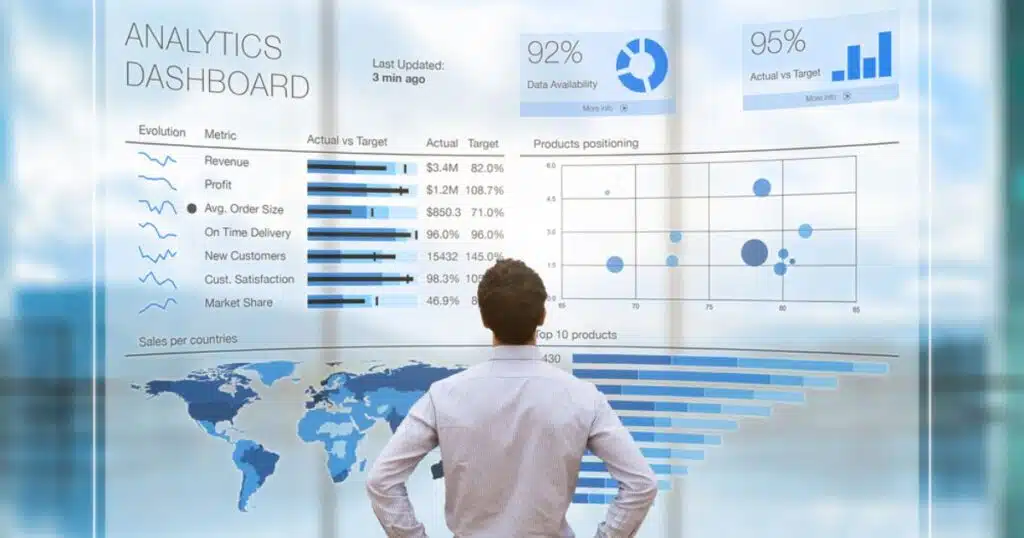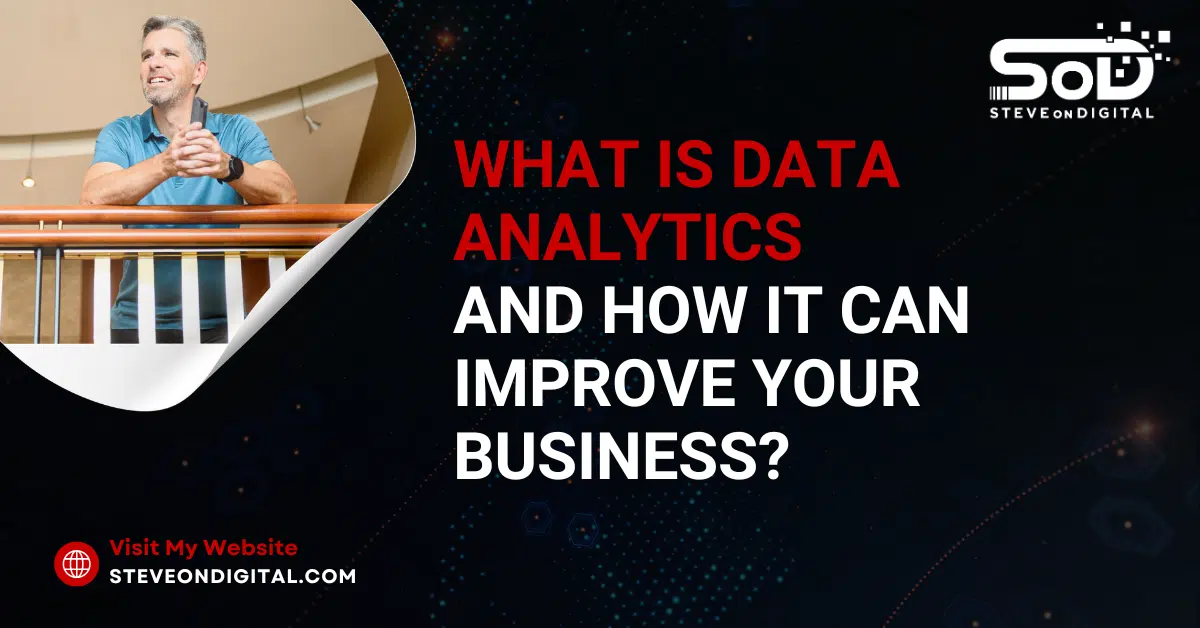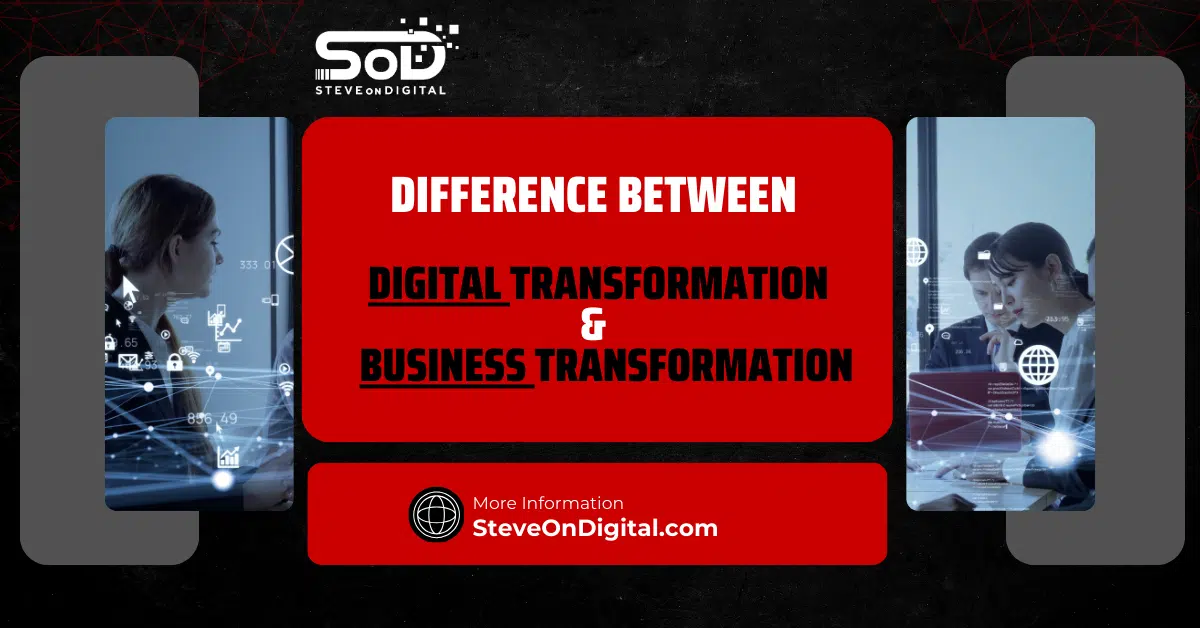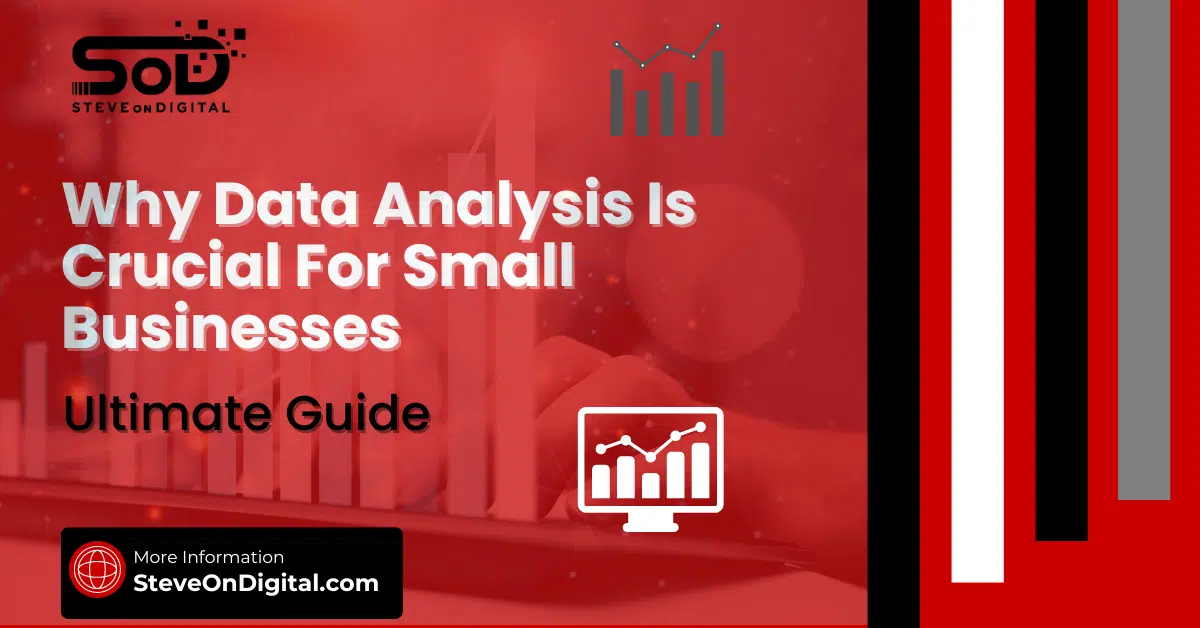In today’s fast-paced and technology-driven world, data analytics stands as a cornerstone of modern business.
As Steve Johnston, owner and author of SteveOnDigital, I’ve witnessed firsthand the transformative power of data analytics across various sectors.
Data analytics involves examining raw data to glean insights that inform business decisions, enhancing efficiency and profitability.
Business intelligence plays a critical role in this landscape, providing the necessary tools and frameworks to understand vast amounts of data effectively.
Core Concepts: Data Analytics, Business Intelligence, And Customer Data
Data analytics is not just a buzzword but a fundamental component of strategic decision making in many businesses today, including small and medium-sized enterprises (SMEs).
By integrating data analytics, business intelligence, and insights derived from customer data, companies can unlock new opportunities and gain a competitive edge.
From optimizing supply chains to tailoring marketing strategies, the impact of data analytics is profound and far-reaching.
Understanding The Data Analytics Process
From Data Collection To Data Analysis
The data analytics process starts with collecting raw data, which can range from sales figures and customer interactions to market trends and beyond.
This raw data is often voluminous and unstructured, making it challenging to process.
However, with the right tools and techniques, such as data science and machine learning, this data is transformed into structured, analyzable sets.
Once structured, the process of analyzing data begins, using statistical tools and algorithms to identify patterns, trends, and relationships.
Exploring Data Types
In my experience, understanding the difference between unstructured data and structured data is crucial.
Unstructured data, such as emails, videos, and social media posts, is formless and not easily sorted through traditional data models.
On the other hand, structured data is organized and easily searchable, often stored in relational databases.
Effective data analytics requires tools that can handle both types, integrating them into a coherent analysis that supports business intelligence.
Role Of Data Analysis In Business Strategy
Leveraging Historical And Sales Data For Strategic Planning
Analyzing historical data and sales data allows business leaders to not only assess past performance but also to forecast future trends and prepare accordingly.
For instance, by examining historical sales data, businesses can predict customer demand, optimize stock levels, and even adjust pricing strategies to maximize profits.
This predictive analytics approach is something I often discuss on my platforms like YouTube and LinkedIn, illustrating its importance with real-life examples from SMEs.
Real-World Success
One compelling case study involves a retail client who leveraged data analytics to revamp their inventory management system.
By analyzing customer data and sales data, they could better predict which products would be in high demand.
This not only reduced overstock and understock situations but also enhanced customer satisfaction as popular items were always in stock.
Another example is a service provider who used customer feedback and data analysis to refine their service offerings, significantly increasing customer retention and satisfaction.
In both examples, the businesses utilized data analytics to not only understand their current market position but also to anticipate market trends and adapt their strategies accordingly.
As someone deeply embedded in the digital transformation space, I’ve advised numerous companies on similar strategies, ensuring they harness the full potential of their data to drive business success.
How Data Analytics Enhances Customer Understanding
Analyzing Customer Behaviors And Trends
Understanding customer behavior is pivotal in today’s business environment.
As the head of SteveOnDigital, I have consistently leveraged data analytics to delve deep into customer trends and behaviors.

This approach is essential because it allows businesses to understand what motivates customer actions, preferences, and buying patterns.
By analyzing customer data and observing how these trends evolve, businesses can tailor their products and marketing strategies to meet the precise needs of their consumer base, leading to increased customer satisfaction and loyalty.
Enhancing Customer Experiences Through Data Insights
One effective technique for analyzing customer interactions involves the use of sophisticated data analytics tools that track and record every touchpoint a customer has with your business.
This might include website visits, social media interactions, and direct communications.
By employing data science and machine learning algorithms, we can extract actionable insights from this data, helping to refine customer service approaches, personalize communication, and ultimately enhance the overall customer experience.
For instance, through my digital platform, we’ve implemented chatbots that analyze incoming customer queries to provide instant, relevant responses that are tailored to individual needs, significantly improving user satisfaction.
Predictive Analytics And Identifying Market Trends
Forecasting The Future With Predictive Analytics
Predictive analytics is a form of advanced analytics that uses historical data along with machine learning and statistical algorithms to predict future outcomes.
In my role at SteveOnDigital, I’ve used predictive analytics to anticipate customer demand and spot emerging market trends before they become apparent.
This capability is crucial for adjusting business strategies dynamically and ensuring competitive advantage.
For example, by analyzing historical sales data and customer behavior patterns, we can forecast which products will see increased demand, allowing for better stock management and marketing focus.
Staying Ahead Of Market Changes Through Predictive Models
The main benefit of predictive modeling is its ability to provide business leaders with foresight, rather than just insight.
This forward-looking approach not only helps in anticipating changes in the market but also in preparing more robustly for potential disruptions.
Predictive models can identify trends that inform product development, marketing strategies, and even risk management practices, helping businesses stay one step ahead of competitors and align more closely with customer expectations and needs.
| Metric | Before Predictive Analytics | After Predictive Analytics | Improvement |
| Forecast Accuracy | 70% | 90% | 20% increase |
| Customer Demand Prediction | 65% | 88% | 23% increase |
| Market Trend Identification | 60% | 85% | 25% increase |
Using Data To Streamline Operations And Reduce Costs
Optimizing Business Operations With Data Analytics
Data analytics is instrumental in streamlining operations within a company.
By analyzing data from various business operations, companies can identify inefficiencies and areas for improvement.
For example, in my experience, by analyzing workflow and production data, we have been able to optimize processes to reduce waste and increase throughput.
Moreover, data analytics allows for the automation of routine tasks, which not only speeds up operations but also reduces the likelihood of human error, thereby saving costs and improving efficiency.
Cost Reduction And Efficiency Gains From Data Insights
One tangible example from my consultancy practice involves a manufacturing client who was struggling with logistical inefficiencies.
By analyzing their supply chain and production data, we identified bottlenecks that were causing delays and increased costs.
With targeted data analytics, we were able to reconfigure their supply routes and optimize the production schedule, which resulted in a significant reduction in costs and improved the operational efficiency of the business.
Another example includes using diagnostic analytics to monitor and predict equipment failures before they occur, thereby minimizing downtime and maintenance costs.
Improving Decision-Making With Business Intelligence
Data Science And BI In Decision Making
Business intelligence and data science have profoundly transformed how decisions are made in the modern business landscape.

As someone who has navigated through multiple aspects of digital transformation, I’ve observed that leveraging these tools can significantly enhance the precision and effectiveness of business decisions.
Business intelligence systems compile and analyze current and historical data to provide comprehensive insights, while data science uses more complex algorithms, predictive models, and machine learning techniques to forecast future scenarios.
These methodologies enable businesses to move from a reactive to a proactive stance, ensuring decisions are not just based on past experiences but are also informed by predictive insights about future trends and behaviors.
This shift is crucial for staying relevant in a rapidly evolving market.
| Benefit | Description |
| Improved Accuracy | Higher precision in forecasting and trend analysis. |
| Enhanced Efficiency | Faster processing and analysis of large data sets. |
| Proactive Decision Making | Ability to anticipate future trends and prepare strategies. |
| Cost Reduction | Identifying cost-saving opportunities through data insights. |
| Personalized Customer Interactions | Tailoring customer experiences based on behavior analysis. |
The Critical Roles Of Data Scientists And Analysts
Data scientists and data analysts are the linchpins in transforming raw data into insights that can drive strategic business decisions.
In my experience at SteveOnDigital, the role of these professionals has been indispensable.
Data scientists apply advanced mathematical models to predict future patterns, while data analysts focus on extracting meaningful trends from data sets.
For example, in a project aimed at increasing customer retention, our data analysts used customer behavior data to identify key factors leading to churn.
Data scientists then developed predictive models to flag at-risk customers before they defected.
The insights provided were used to tailor personalized marketing strategies that significantly improved customer retention rates.
Such precise targeting would not be possible without the deep analytical capabilities provided by these experts.
Achieving Competitive Advantage Through Data Insights
Data-Driven Competitive Strategies
Data analytics is a powerful tool for gaining a competitive advantage because it allows businesses to identify and act upon opportunities much quicker than competitors.
By analyzing market trends, customer data, and other relevant data, companies can discover untapped markets, predict consumer needs, and adjust their strategies accordingly.
For instance, through data analytics, a business can detect a surge in demand for a product in a specific region or demographic before competitors are aware of the shift.
This ability to swiftly respond to market demand not only boosts sales but also enhances the brand’s reputation as responsive and customer-focused.
Gaining A Competitive Edge With In-Depth Data Analysis
A deep understanding of data can significantly sharpen a company’s competitive edge.
This involves not just knowing what the data says, but also understanding how to apply this knowledge strategically across various aspects of the business, from marketing and sales to supply chain management and customer service.
One practical example from my advisory work involves a retail client who utilized data insights to optimize their inventory levels and distribution strategies based on predictive analytics of buying patterns.
This not only reduced overhead costs but also improved service levels, positioning them ahead of competitors who were slower to adapt to these insights.
The Future Of Business: Machine Learning And AI
Integrating AI And Machine Learning In Data Strategies
As the digital landscape evolves, machine learning and artificial intelligence have become integral to business analytics.
These technologies enhance our ability to analyze large sets of data with a level of accuracy and efficiency that is unattainable by human analysts alone.
In my experience at SteveOnDigital, applying AI has allowed for more precise predictions and smarter decision-making processes.
Machine learning algorithms learn from past data, improving over time, which significantly enhances their ability to identify patterns and predict future outcomes.
This is crucial for businesses that need to adapt swiftly to changing market conditions.
Anticipating The Future
Looking ahead, the integration of AI and machine learning in data analytics is set to reshape business models across industries.
We can anticipate a shift towards more data-driven strategies, where decisions are continually refined based on real-time data inputs.

This shift not only impacts operational efficiencies but also customer interactions, where personalization and responsiveness can greatly enhance the customer experience.
For example, AI can help tailor product recommendations to individual preferences, altering the traditional sales approach and potentially increasing profitability.
Case Studies
Transformations Achieved Through Data Analytics
One notable example is a major online retailer that implemented data analytics to optimize its supply chain and inventory management.
By analyzing customer data and purchasing patterns, the company could predict product demand more accurately, reducing overstock and stockouts.
This not only improved their operational efficiency but also boosted customer satisfaction by ensuring popular items were always in stock.
Another success story involves a healthcare provider that used predictive analytics to improve patient outcomes by analyzing treatment data and predicting patient risks based on their conditions and treatment plans.
Data-Driven Performance And Marketing Success Stories
Data analytics has also proven effective in enhancing employee performance and optimizing advertising campaigns.
By analyzing employee data, companies have been able to identify key performance indicators, optimize training programs, and enhance employee engagement strategies.
Similarly, data-driven insights have transformed advertising campaigns by enabling businesses to identify the most effective marketing channels and tailor their messages to specific segments of the consumer base, thereby maximizing the return on investment.
| Company | Industry | Data Analytics Application | Impact |
| Online Retailer | E-commerce | Supply chain and inventory optimization | Reduced stockouts and overstock |
| Healthcare Provider | Healthcare | Predictive analytics in patient care | Improved patient outcomes |
| Tech Startup | Technology | Employee performance and advertising campaigns | Increased employee engagement and ROI in ad spend |
Conclusion
Key Benefits Of Data Analytics For Business
Data analytics offers a multitude of benefits that can transform businesses by enabling more informed decision-making, enhancing operational efficiency, and improving customer satisfaction.
Through the strategic application of data analytics, businesses can gain a deep understanding of market trends, consumer behavior, and internal business processes, which leads to better strategic planning and risk management.
A Call To Action
As we look to the future, the importance of integrating data analytics into business operations cannot be overstated.
For businesses aiming to remain competitive and innovative, adopting data analytics is not just an option but a necessity.
The insights gained from data analytics equip business leaders to make more informed decisions that can lead to sustained growth and improved business performance.
In conclusion, whether you are looking to optimize your operations, enhance customer experiences, or drive innovation, data analytics provides the tools necessary to achieve these goals.
At SteveOnDigital, I have helped numerous businesses harness the power of data to redefine their strategies and achieve remarkable success.
I encourage all businesses to consider how data analytics can be integrated into their operations to not only survive but thrive in this data-driven era.




